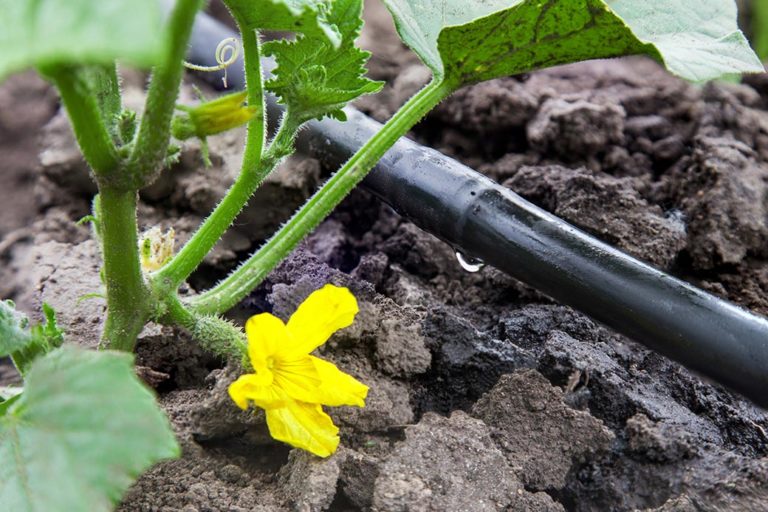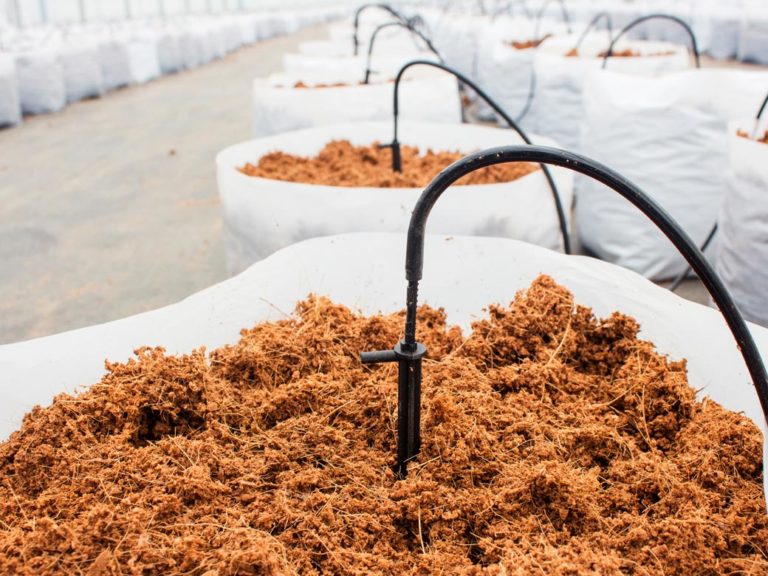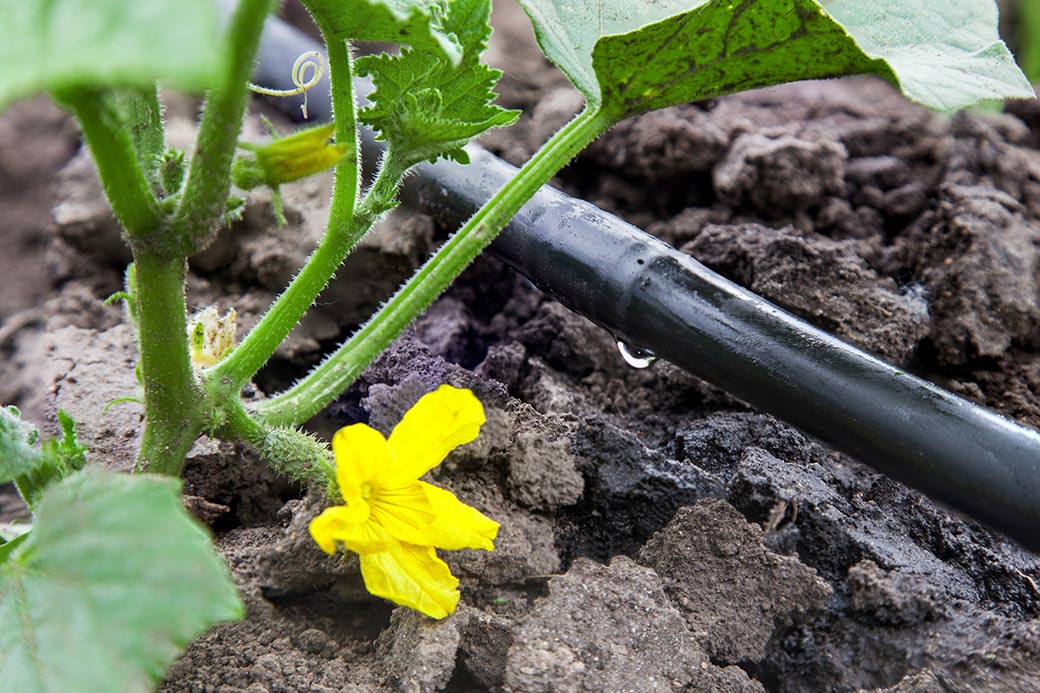Learning how to water hydroponic plants is vital to achieve healthly plants and high yields. Water too often and you’ll suffocate your plant’s roots and deal with mold growth. Water too infrequently and your brittle plants won’t grow as they should.
That’s why it’s so important to learn about proper watering techniques and how to recognize when your plant is getting too much or too little water. Proper irrigation relies on a lot of observation and adjustments. With this said, don’t expect one clean answer as to how much you should irrigate.

Why is Water Important?
Before we dive into how to properly water plants, let’s first look at the role of water in plants.
Although you may not realize it, plants cool themselves through the release of water. In a way, they sweat too!
In this process known as transpiration, plants release water through small openings in their leaves called stomata. When water converts from a liquid to a vapor, energy is released in the form of heat. This release of heat helps keep plants cool.
Transpiration also helps plants take up nutrients. In order to replace the water lost through the stomata, plants take up liquid through their roots. This solution is mostly water, but it also contains dissolved nutrients.
One more way transpiration helps plants is by allowing the uptake of carbon dioxide. When stomato are open for transpiration, carbon dioxide is able to enter through the leaves. Carbon dioxide is neccesary for photosynthesis.
Factors Affecting Water Needs
When determing how much you should water plants, there is no one size fits all measurement. The water plants require depends on the following factors:
Plant species
Different plant species have different water needs.
Age and size of plant
Larger plants take up more water than smaller plants. Therefore, the water demand is greater for larger plants.
Temperature of growing area
At higher temperatures, plants will lose more water through transporation. Therefore, higher temperatures demand more water.
Light
Light impacts temperature and how much plants transpire.
Media composition
Different medias hold different amounts of water.
Calculating Optimal Soil Moisture
While the vaiables mentioned above impact how much water plants require, all plants perform best at a simlar soil moisture range. This range is known as the optimal moisture range.
This range occurs below saturation but above the drying point of soils. Basically, it is the point where most soil pores are filled with water, but some are still filled with air.
One simple way to determine if your soil is close to optimal moisture is by look and feel. If water is ponding and running of of the soil surface, soil is likely above optimal moisture. However, when soil feels dry to the touch, it is likely below optimal moisture.
If you’re looking for a more precise measurement of soil moisure, there are a number of devices available to monitor soil moisture.
How to Spot and Fix Issues with Overwatering
Overwatering is one of the most common problems that novice growers face. It’s easy to assume that the growing plants need lots of water every single day, but that’s not always true.
On top of taking in water with their roots to stay hydrated, plants rely on the roots to take in air as well. When they’re constantly saturated with water they actually begin to drown.
Some symptoms of overwatering, such as discolored leaves, are similar to the symptoms of nutrient deficiencies. So, investigate to see what cause makes sense.
Overwatering Symptoms
- Droopy leaves – The leaves become so full of water that they curl inward and become firm.
- Slowed growth – growth will slow and even stop due to the lack of regular oxygen exposure.
- Yellow leaves – Too much watering creates a nutrient imbalance that leads to yellowing leaves.
- Root rot – Continously damp soil leads to rot
Correcting Overwatering
If you’ve been watering your crops on a daily basis and they’re suffering from any of the above symptoms, cut back on how frequently you water. Stop watering every day and start feeling the media before watering. Better yet, monitor your media with a device.
Making this one change will give the roots of your plants a chance to breathe and should correct most over watering problems. It will also teach you about how often you should be watering your plants, which varies depending on your climate and type of plant.
How to Spot Issues with Under Watering
Underwatering plants is also a serious issue; it can prevent optimal growth and lead to plant death over time. To avoid this issue, check soil moisture levels each day.
Signs of Under Watering
By the time you see signs of under watering, plants are already experiecing moderate drought stress. These signs include:
- Wilting leaves
- Brittle and papery leaves
- Lifeless or dull looking plant
Correcting the Issue
If you’re plants aren’t getting enough water, water them more than you currently are. Test the media regularly to determine when you need to irrigate.

Use High Quality Water
Your plants will be healthiest when you use high-quality water. To achieve this you need to monitor and adjust pH and PPM in your water source.
The water’s pH should be kept around 6.5 when possible, making it slightly acidic.
The PPM of your nutrient solution should be adjusted carefully as well. Try and keep the PPM to between 700 and 1000 during the vegetative stage and closer to 1,250 during flowering. Use a total desolved solids (TDS) meter to monitor the PPM and adjust your nutrients appropriately.
It’s important to note, there are different measurements for TDS, and not all meters (or nutrient companies) use the same measurement. It’s kind of like feet vs meters. They both measure distance, but 1 meter is much larger than 1 foot. We’re using the TDS / PPM 700 scale here, but there is also the 500 scale which tends to have lower numbers.
Setting Your Grow Up for Healthy Hydration
Maintaining proper soil moisture is easier with the proper set up. There are a variety of products available to help make irrigation easier.
Utilize Drip Lines
Serious growers should be relying on drip lines rather than hand watering or overhead sprinklers. Drip lines make it easy to distribute water evenly throughout containers or grow beds. Install drip lines around each of your plants and you will evenly water each one.
Drip lines also prevent plant tissues from becoming wet. This helps prevent issues with fungal diseases, such as powdery mildew.
How Long to Water Plants with Drip Irrigation
Just as with all irrigation practices, there’s not one correct answer to “how long should I water my plants?” The answer depends on factors listed above, such as growing media, size of plant, and air temperature.
When you water your plants, you want the media to become throughly wet. Therefore, you shouldn’t water for 10 seconds 20 times a day. It’s better to water for a period of at least a few minutes. Some setups require drip irrigation to only run over other day for five minutes. Other setups require five waterings throughout the day. Remember, use observation and adjust accordingly.
Simplify with a Water Timer
To keep your plants healthy, it’s important to know how much water you are providing through irrigation. A water timer is the most accurate way to do this. By using a water timer you can precisely control how much water the plants are receiving.
If your soil moisture level is too low afer watering, you can increase the amount of water they recieve the following day. If they showed symptoms of overwatering, you can drop the frequency or quantity by adjusting the timer. Eventually the timer will help you keep your plants at healthy hydration levels all the time.
Choose Containers with Care
If you’re growing in containers, it’s important that these provide proper drainage. Canvas containers are an optimal choice for good water management and plant health for three reasons.
Canvas material is breathable and gives plant roots access to air whenever they need it. It’s also porous and allows water to drain out. Finally, a good canvas container won’t trap heat, which helps keep plants at healthy temperatures even in hot climates.
It’s also vital to size up containers over time to keep plants housed in the right size container. Usually, the plants grow too quickly to have too many intermediary steps, but oversized containers are a waste of space, time, and energy. The moment your plant’s root system fills all the soil in the container, it’s time to move them to the next container size up.
Choosing Media
For a successful grow, it’s important to balance good drainage and water retention. That’s why you must adjust your media composition with care to make sure excess water can be drained effectively. Media composition is arguably even more important than the container it’s held in.
How Much Water Per Gallon of Soil?
Even though we’re talking about hydroponic irrigation, people often asked about watering in soil-based systems. As you probably know, not all soils are the same! The composition of the soil will impact it’s water-holding and draingage capacities.
Soils high in clay will require less water than sandy soils. This is because clay helps hold water. Additions such as perlite also increase the amount of water a soil needs, since perlite increases drainage.
How Water Needs Change
Your plant will need different amounts of water during different stages of it’s growth cycle. So, learn out how to water hydroponic plants during each stage of growth.
How Often to Water New Plants
When you get a new plant, it will likely be small. If this is the case, it won’t need as much water as a larger, more mature plant. Remember, smaller plant equals less transpiration. And less transpiration equals less water loss.
Your goal is to provide the optimum amount of water so your new plant can start growing. Aim to keep your growing media moist, but not damp. This could require anywhere from 1-15 waterings per day, depending on your grow environment.
How Often to Water During Flowering
When your plants enter the flowering stage, they still need water. After all, they’re still alive!
You might find that your plants need more water during flowering than during the later stage of vegetative growth. As with all stages of growth monitor your media to maintain optimal moisture.
When Should I Stop Watering Before Harvesting?
While it may sound counterintunitive, you want to stress your plants by stopping watering them. By doing so, you increase the amount of desirable compounds in the bud.
It’s best to stop watering 1-3 days before harvesting. Your plants should look a little stressed, but not super wilted nor dying.
How Much Water to Flush Plants?
When you’re flushing plants, use just as much as you would when you are applying your nutrient solution. The only difference is that you aren’t applying nutrients, only water.
Healthy Watering Practices
As one of plant’s key needs, it’s important to provide your plants with water. With so many factors contributing to proper plant irrigation, determing just how much to water your plants may seem confusing.
However, you’re on your way to understanding how to water hydroponic plants. By doing so, you’ll see increased crop growth and plant health.
References
Everything About Flushing Your Cannabis Plants
Introduction to the Soil-Water-Plant Environment
